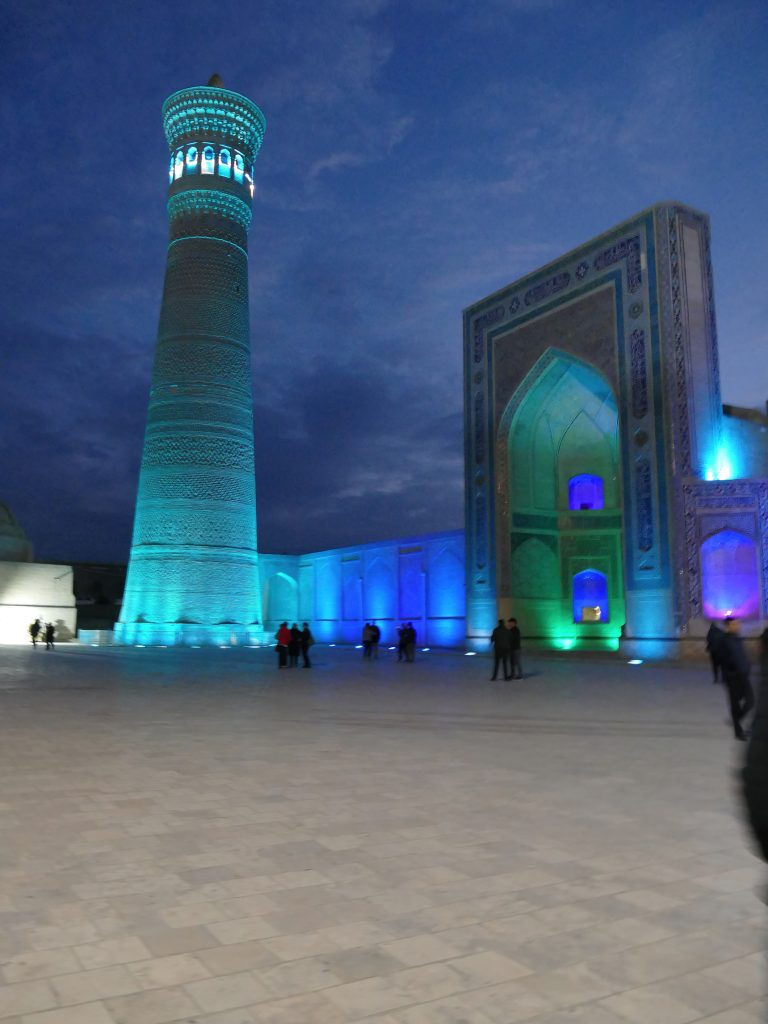
Cascoly Travel 2024 Uzbekistan Small Group Tour
Join our 2024 Small Group Turkey Tours – Turkey, Uzbekistan & Bulgaria
It had been 40 years since
I’d been in the Silk Road cities of Uzbekistan, so I was looking forward to our scouting trip in November 2023. Lutfi & I planned to lead a small group there in 2024. We stayed in small hotels within easy walking distance to the main sites, allowing comfortable walking in the evenings. Lutfi found most Uzbeks spoke at least some Turkish.
We’d been prepared for cold weather in November so were pleasantly surprised to be greeted by unseasonably warm days of 60-70⁰ F (compared to my previous 2 weeks in Europe of 50⁰-low 60⁰s). In just a week we spent long but pleasant days re-discovering the 4 main cities of Tashkent, Samarkand, Bukhara and Khiva. There were few tour groups, but enjoyed meeting solo travelers from Russia, Spain and Korea at our hotel breakfasts.
Soviet archaeologists had done a reasonable job of preserving and restoring ancient sites, particularly in Tashkent after the devastating earthquake of 1966 which destroyed most buildings. While they also restored Russian colonial buildings of the 19th century, they rebuilt large sections of the city in Soviet ‘brutalist’ style. Since independence restoration continues at a faster pace. The biggest difference I noticed was a transformation of the stark Islamic and Timurid ruins to include shops and local crafts folk. And the cities have many more restaurants and improving tourist infrastructure. Tourism has exploded to over 5 million in 2022 and over 3 million in the first 6 months of 2023 (even before the high season of Aug-Sep) from just over 1 million in 2016. Most of those are from neighboring countries, Russia and China, with less than 50,000 from the EU and about 15,000 from the US.


In 2024 we’ll expand to 11 days for a more leisurely pace. We also plan to go in September with it’s more reliable comfortable temperatures. E-visa are available, and no visa is required for USA citizens over 55 years old
Uzbek Air – A Safety Briefing You’ll Actually Enjoy
Contact us for pricing and signup
Our proposed itinerary (dates may change slightly):
Itinerary for Cascoly Travel 2024 Uzbekistan Small Group Tour
The history of Uzbekistan is rich and diverse, reflecting its position as a crossroads of various civilizations and cultures. Here’s a brief overview:
Ancient Period
Early Civilizations: The region of present-day Uzbekistan has a long history of human habitation, with evidence of early human activity dating back to the Paleolithic era.
Persian and Greek Influence: In the first millennium BCE, the region was influenced by Persian and Greek cultures. The Persian Empire, particularly the Achaemenid Empire, had a significant impact on the area.
Islamic Period:
Arab Conquests: In the 7th century, the Arab Caliphate conquered Central Asia, bringing Islam to the region. The cities of Samarkand, Bukhara, and Khiva became important centers of Islamic civilization and trade.
Seljuk and Mongol Invasions: The Seljuk Turks and later the Mongols, led by Genghis Khan, invaded the region in the 11th and 13th centuries, respectively, bringing about significant changes.

Timurid Empire:
Timur (Tamerlane): In the 14th century, the Turko-Mongol conqueror Timur, also known as Tamerlane, established the Timurid Empire, with its capital in Samarkand. Timur’s empire was known for its cultural achievements and architectural wonders.
Uzbek Khanates:
Uzbek Tribes: The Uzbek tribes, originally from the northeast, migrated into the region in the 15th century. They established the Shaybanid Khanate, which later split into several smaller khanates, including Bukhara and Khiva.
Russian and Soviet Period:
Russian Expansion: In the late 19th century, the Russian Empire expanded into Central Asia, including present-day Uzbekistan. The region became part of the Russian Empire, and later the Soviet Union.
Soviet Era: During the Soviet period, Uzbekistan experienced significant industrialization and social change. Cotton became a major cash crop, and the economy was largely based on agriculture and resource extraction.
Independence:
Dissolution of the Soviet Union: With the collapse of the Soviet Union in 1991, Uzbekistan declared its independence. Islam Karimov became the country’s first president, and he remained in power for over two decades until his death in 2016.
Post-Independence: Uzbekistan has faced various challenges in the post-Soviet era, including economic reforms, political changes, and social development. The country has sought to strengthen its ties with other Central Asian nations and the broader international community.
Today, Uzbekistan is known for its cultural heritage, including its historic cities, Silk Road sites, and diverse ethnic groups. The country continues to navigate its path in the post-Soviet era, balancing economic development and political stability.